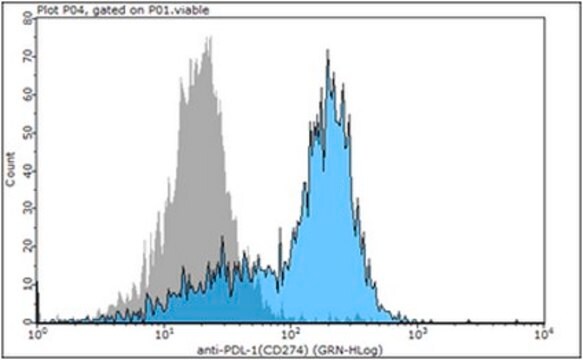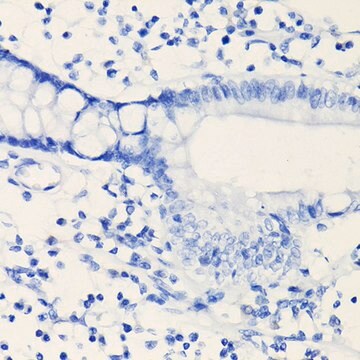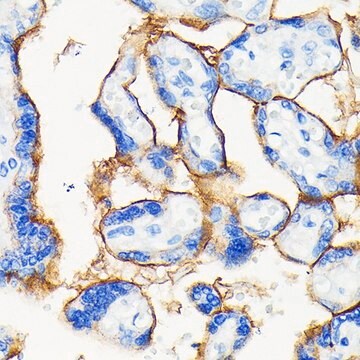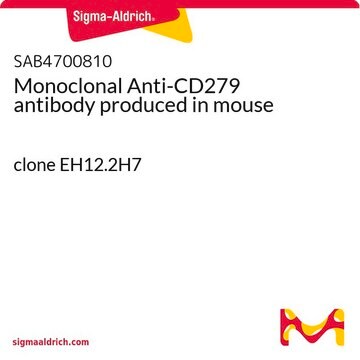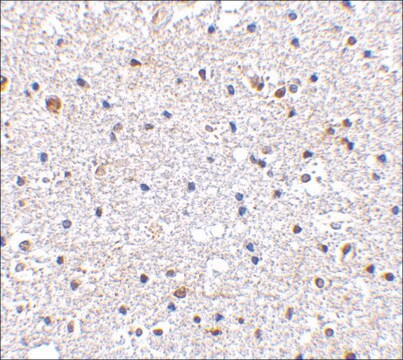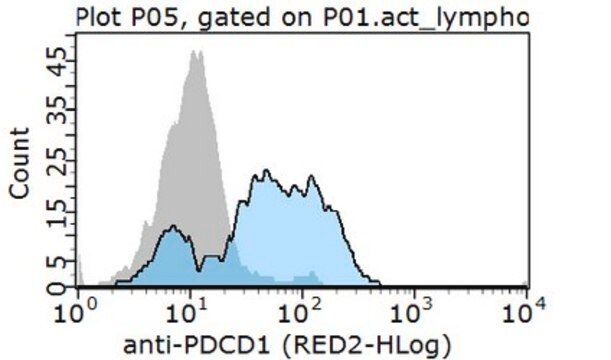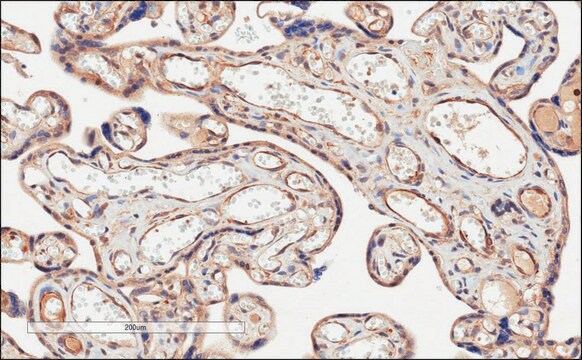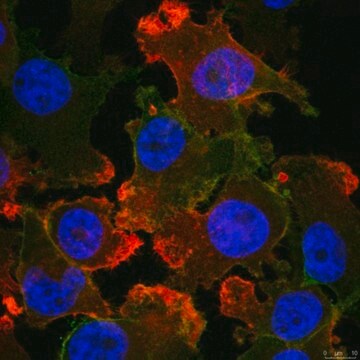MABC980
Anti-PD-L1 Antibody, clone 29E.2A3.C6, Azide Free
clone 29E.2A3.C6, from mouse
Sinônimo(s):
Programmed cell death 1 ligand 1, B7-H1, B7 homolog 1, CD274, PD-L1, PDCD1 ligand 1, Programmed death ligand 1
About This Item
Produtos recomendados
fonte biológica
mouse
Nível de qualidade
forma do anticorpo
purified immunoglobulin
tipo de produto de anticorpo
primary antibodies
clone
29E.2A3.C6, monoclonal
reatividade de espécies
rat, chimpanzee, human
técnica(s)
flow cytometry: suitable
immunocytochemistry: suitable
immunohistochemistry: suitable (paraffin)
neutralization: suitable
Isotipo
IgG2bκ
nº de adesão NCBI
nº de adesão UniProt
Condições de expedição
dry ice
modificação pós-traducional do alvo
unmodified
Informações sobre genes
human ... CD274(29126)
Descrição geral
Especificidade
Imunogênio
Aplicação
Flow Cytometry Analysis: 0.1 µg of this antibody from a representative lot detected PD-L1 in MDA-MB-231 cells.
Flow Cytometry Analysis: A representative lot immunostained the surface of 300.19 murine pre-B lymphoma cells transfected with human PD-L1, but not the untransfected cells or cells transfected with human PD-L2 (Brown, J.A., et al. (2003). J. Immunol. 170(3):1257-1266).
Flow Cytometry Analysis: A representative lot detected surface PD-L1 expression on human breast cancer cell lines MDA-231, SKBR-3, and MCF-7, but not BT-474 (Latchman, Y., et al. (2001). J. Nat. Immunol.2(3):261-268).
Immunohistochemistry Analysis: A representative lot detected PD-L1 expression pattern in frozen fetal (thymus & cardiac tissue) and paraffin-embedded adult (tonsillar germinal center and placenta) human tissue sections (Brown, J.A., et al. (2003). J. Immunol. 170(3):1257-1266).
Immunohistochemistry Analysis: A representative lot detected PD-L1 expression in paraffin-embedded human cancer tissue sections, including anaplastic large cell lymphoma, squamous cell carcinoma of the tongue, colon adenocarcinoma, and invasive breast ductal carcinoma (Brown, J.A., et al. (2003). J. Immunol. 170(3):1257-1266).
Neutralizing Analysis: A representative lot competed against human PD-1 extracellular domain Ig fusion for the binding of exogenously expressed human PD-L1 on the surface of 300.19 murine pre-B lymphoma cells (Brown, J.A., et al. (2003). J. Immunol. 170(3):1257-1266).
Neutralizing Analysis: A representative lot enhanced cytokines production from CD4 T-cells upon HIV Gag peptides stimulation of CD8+-depleted human PBMCs (Porichis, F., et al. (2011). Blood. 118(4):965-974).
Neutralizing Analysis: A representative lot restored HCV peptides-induced expansion of CD8+ T cells in cultured intrahepatic lymphocytes from a chimpanzee with 10 years of chronic HCV infection (Fuller, M.J., et al. (2013). Proc. Natl. Acad. Sci. U. S. A. 110(37):15001-15006).
Neutralizing Analysis: Dual blockage of both DP-L1 clone 29E.2A3.C6 Fab fragment and DP-L2 by clone 24F.10C12 (Cat. No. MABC969) Fab fragment on PBMC-derived dendric cells (DCs) boosted the enhancing effect on CD4+ T-cell proliferation and cytokine release seen with DP-L2 blockage alone in allogenic cultures with immature DCs (iDC), mature DCs (mDC), and IL-10-treated mDCs (Brown, J.A., et al. (2003). J. Immunol. 170(3):1257-1266).
Immunocytochemistry Analysis: A representative lot detected an upregulated PD-L1 immunoreactivity in human CD14+ monocyte-derived macrophages (MDMs) following HIV infection or TLR4/8 stimulation (by LPS or CL097 treatment) by fluorescent immunocytochemistry using paraformaldehyde-fixed MDMs (Rodríguez-García, M., et al. (2011). J. Leukoc. Biol. 89(4) 507–515).
Apoptosis & Cancer
Apoptosis - Additional
Qualidade
Immunohistochemistry Analysis: An 1:50 dilution of this antibody detected PD-L1 in human cerebral cortex tissue.
Descrição-alvo
forma física
Armazenamento e estabilidade
Handling Recommendations: Upon receipt and prior to removing the cap, centrifuge the vial and gently mix the solution. Aliquot into microcentrifuge tubes and store at -20°C. Avoid repeated freeze/thaw cycles, which may damage IgG and affect product performance.
Outras notas
Exoneração de responsabilidade
Not finding the right product?
Try our Ferramenta de seleção de produtos.
Código de classe de armazenamento
12 - Non Combustible Liquids
Classe de risco de água (WGK)
WGK 2
Ponto de fulgor (°F)
Not applicable
Ponto de fulgor (°C)
Not applicable
Certificados de análise (COA)
Busque Certificados de análise (COA) digitando o Número do Lote do produto. Os números de lote e remessa podem ser encontrados no rótulo de um produto após a palavra “Lot” ou “Batch”.
Já possui este produto?
Encontre a documentação dos produtos que você adquiriu recentemente na biblioteca de documentos.
Nossa equipe de cientistas tem experiência em todas as áreas de pesquisa, incluindo Life Sciences, ciência de materiais, síntese química, cromatografia, química analítica e muitas outras.
Entre em contato com a assistência técnica